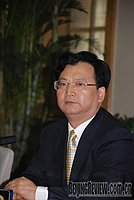| Shaanxi is considered one of the cradles of the Chinese civilization. In 2008, Shaanxi's GDP increased 15.6 percent, posting the fourth fastest increase of all China's provinces. Despite the ongoing economic crisis, Shaanxi has been preparing itself for the next round of economic growth.
 |
|
HIGH HOPES: Jing Junhai, Vice Governor of Shaanxi Province, says the energy, chemical, equipment manufacturing, and hi-tech industries will be the "leading forces" of the province's further economic development (LIU XINLIAN) | Jing Junhai, Vice Governor of Shaanxi Province, sums up Shaanxi's advantages in six areas, namely its long history, rich resources, strong education and science programs, good environment, fast development and great opportunities for further social and economic development.
Shaanxi is one of the provinces with the richest mineral resources with its considerably large quantities and wide varieties. It has 91 types of mineral resources, among which the proven reserve of 58 types ranks in the top 10 in China. Proven reserves show that the potential value of mineral reserves in Shaanxi exceeds 42 trillion yuan ($6.2 trillion), or nearly one third of the total amount in China, ranking first in the country in this regard, Jing said.
With more than 1,000 academic institutions, 126 universities and more than 1.1 million scientists and engineers working in various fields, Shaanxi's comprehensive strength in science and education has always taken a leading position in China, Jing said.
With its tremendous development in highway traffic, railway construction and aviation, Shaanxi has increasingly become west China's transportation hub. By 2008, the total mileage of expressways in Shaanxi reached 2,467 km, ranking first in west China. The second-stage expansion project of Xi'an Xianyang International Airport will turn it into the fourth largest aviation hub of the country behind airports in Beijing, Shanghai and Guangzhou.
Fighting the crisis
Despite its achievements, Shaanxi has been impacted by the global economic crisis and lowered its economic development goals for 2009. Its provincial government has forecasted a 13-percent GDP growth rate for 2009-still the highest among all the provinces.
"We know it will bring about a lot of pressure," Jing said. Economic performance in the first quarter was not as good as the same period last year.
When asked how the province would achieve the goal, Jing pointed to Shaanxi's abundant energy resources and said the energy, chemical, equipment manufacturing, and hi-tech industries would be the pillar industries and "leading forces" of the province's economic development.
He also stressed the importance of the transformation of the province's economic development model. In the past, Shaanxi used to sell raw coal, but in the future, it would sell coal-generated electricity and develop a coal chemical industry and oil chemical industry, all of which would prolong its industrial chain and add value to its raw material, Jing said. The development of energy chemical industry would produce more opportunities for the equipment manufacturing industry-an advantageous industry for Shaanxi-he said.
Jing also emphasized the role that the aircraft industry would play in Shaanxi's equipment manufacturing industry. In the future, Shaanxi would produce 20 percent of China's large-scale passenger planes and most of its large-scale cargo aircraft, he said.
Jing said that by focusing on increasing investment, tackling the difficulties in industrial development, working hard to promote consumption and attracting investment, Shaanxi would achieve its 13-percent GDP growth goal for this year.
"If we say that in the past 30 years, there have been great spaces and opportunities [for economic growth] in east China, I think it is also fair to say that west China will provide greater space and opportunities in the next 30 years," Jing said.
He went on to explain that with the current constraints on the export-oriented market, the Central Government initiated a plan to boost domestic demand, much of which will be generated by west China where the infrastructure is still not fully developed.
Shaanxi has placed much emphasis on its interaction with east China, both attracting investment from and promoting trade with the region. With investment from east China, Shaanxi has been able to advance its development in leaps and bounds. Conversely, this has enabled eastern enterprises to continue to develop as well, Jing said. He traveled to eastern provinces to attract investment more than 10 times last year, he said.
|
